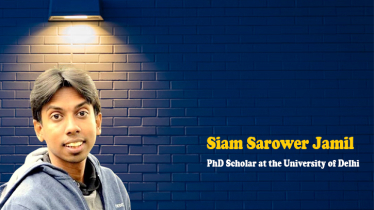
Photo : Messenger
Suicide means the intentional taking of one’s own life. Suicide, the 15th leading cause of death, is an issue that is becoming more and more prevalent everywhere, crossing social, cultural, geographic, and religious divides. Global concern has been aroused by the startling increase in the number of young peoples’ suicides in recent years. Suicide is among the top three global causes of mortality for young people. This has detrimental socioeconomic repercussions and disruptive psychological ramifications, in addition to directly taking many young lives. This is a silent, unacknowledged in terms of policy intervention in Bangladesh. Suicide is a neglected global public health problem and Bangladesh is not an exception. Though suicide attempt is a criminal offence in the law of Bangladesh, to solve this problem, it is essential to investigate the reasons and promote preventative actions.
According to different studies, about 800,000 people die each year from completed suicide, which is a major global public health issue with extensive social, emotional, and financial ramifications. Approximately 80% of suicides occur in nations with low and moderate incomes. An estimated 20–30 times as many attempts are made as successful suicides, and a history of unsuccessful suicide attempts continues to be a significant risk factor for suicide death. These suicide statistics most likely still represent a small portion of actual instances. Suicide registration is a difficult procedure that frequently involves legal authorities. Suicide deaths could go unreported or be mistakenly categorised as accidents or other causes of death. Suicide is the second leading cause of death for individuals aged 15–29 years and the third cause of death for individuals aged 15–44 years. The estimated global annual prevalence of self-reported suicide attempts is approximately 3 per 1,000 adults. About 2.5% of the population makes at least one suicide attempt during their lifetime. According to recent US data, almost one-third of young adults reports having thought about suicide at least once in the previous year. In addition, over the previous ten years, the US had a 57.4% increase in the suicide rate among those aged 10 to 24.
Although almost 60% of suicides worldwide occur in Asia, the continent's two most populous nations—China and India—accounted for 44% of all suicide fatalities worldwide in 2022. Bangladesh, a nation of 170 million people, registers about 10,000 suicide deaths per year, a number that experts claim is rising gradually. In Bangladesh, according to various statistics, suicide tops the list of unusual deaths. Not only that, while 5,200 people died in the country during the first year of the Corona epidemic, 14,436 people committed suicide in the same period. According to another survey, 60.2% of female students and 44.2% of goers committed suicide. Analysing the causes of suicide, it can be concluded that frustration derived from anger was the biggest reason behind the suicide of students in Bangladesh and 165 students, or more than 32%, committed suicide due to this reason. About 15% of students committed suicide due to love affairs and about 10% committed suicide by suffering from mental health problems. It is also important to note that 19 students out of 98 university students who committed were from public universities, including Dhaka University and Chittagong University. In 2022, 532 people, including many students, committed suicide. In Bangladesh, suicide is mostly a rural issue. Despite the fact that the majority of the population lives in rural regions—the World Bank estimates that 63% of Bangladeshis do so—the suicide rate in these areas is still almost 17 times higher than in metropolitan areas. In Bangladesh, reports of suicide and attempted suicide most frequently point to two methods: hanging and pesticide consumption.
Reasons behind suicide:
Since every suicide is the consequence of a complicated, dynamic, and unique interaction between a wide range of contributing circumstances, individual attempts to anticipate and prevent suicide typically end in failure. The susceptibility of young people to suicide is greatly increased by depression, anxiety, and other mental health conditions. Young adults who have a history of drug usage and excessive social media involvement are more likely to experience suicidal thoughts. Adverse family conditions and domestic violence can be major factors in driving young people towards suicide. The other causes responsible for suicide include excessive anger, academic pressure, failure in exams, failure to achieve the desired GPA or results in public exams, sexual harassment, and humiliation. Unfortunately, some religious fanatics oppose the practice of different types of culture and arts, and they also emphasise the life after death instead of celebrating the living life.
Research has consistently demonstrated a strong correlation between suicidal behaviours among Bangladeshi women and girls and the following factors: men's patriarchal dominance over women; lower socioeconomic status of women and girls in the family and society; lower female educational attainments; forced and/or early marriage; divorce or threat of divorce; forced childbearing; conflicts with in-laws; and various forms of abuse and oppression. According to the Bangladesh Mental Health Association, some symptoms include a sharp and unexpected shift from a cheerful attitude towards death to a repeated reflex of hopelessness, helplessness, or desperation- sleeplessness, social withdrawal, loss of appetite, and interest in routine activities.
In today's society, one of the primary causes of suicide is ‘Scolding’. In the audition, ‘bullying’ has always been a contentious topic in educational institutions, and unless we take action to minimise it, it appears that it will continue for a very long time. Apart from this, suicide and mental disorders are intimately related, according to the majority of research. 90% of suicide victims had experienced at least one mental illness. Personality disorders like borderline or antisocial personality disorder are present in 30–40% of suicide deaths. Teens experience anxiety and unease throughout this time as they deal with the challenges of making the transition from childhood to adulthood. Teens frequently feel alone at this challenging time in their lives, alienating them from peers or family. These youths are predisposed to mental health issues by nature, particularly throughout their adolescent years. This stage of life is marked by mobility, adjustments, and simultaneous state shifts in a number of domains. Adolescents must make decisions concerning tangible, significant aspects of their lives, such as their schooling, housing, peer group, etc. And besides, they are often confronted with high expectations, sometimes too high, from significant relatives and peers. Such situations inevitably provoke a certain degree of helplessness, insecurity, stress and a sense of losing control.
Measures to be taken:
The Sustainable Development Goal 3.4.2 targets to reduce suicide by 33% in 2030 through enhanced prevention and treatment measures. Nonetheless, governments and policymakers around the world have not necessarily or consistently considered this as a priority needing intervention. This includes a mental health check-up of all students from school to university level at least once a month, appointing a mentor (counsellor) for each student and taking steps to build good relationships between mentor and student, introducing teacher-student mental health program in educational institutions, training teachers. Even in educational institutions, the psychological crises of students are not identified. They don't even get a place to talk about their problems. Ensuring accessible and comprehensive mental health services can aid in the early identification and treatment of mental health issues among young people. In addition, implementing educational programs that raise awareness about mental health. Besides, teaching coping strategies and reducing the stigma of the students by the university authorities is crucial in fostering a supportive environment for the students. Promoting open communication and parental guidance helps create a strong support system at home, reducing the risk of suicide. Communities can play a vital role by fostering inclusivity, providing resources, and creating a network of support for young individuals. Practice of different types of culture and arts in everyday life is crucial to enjoy the present life and save us from many stressful situations.
Bangladesh clearly needs a specific, inclusive and robust mental health policy that incorporates suicide prevention. Screening aims to identify at-risk individuals and direct them to treatment. Identifying high-risk groups and individuals and extending care and support should be considered a key component for the suicide prevention strategy. The man who commits suicide usually reveals a warning sign of being suicidal. Psychotherapy can have promising results in reducing repetition of suicidal behaviour and improving treatment adherence exist for cognitive therapy. Suicide prevention includes a range of interventions focused on community or organisational gatekeepers whose contact with potentially vulnerable populations provides an opportunity to identify at-risk individuals and direct them to appropriate assessment and treatment.
The writer works as Senior Assistant Secretary (Admin) at the University Grants Commission of Bangladesh (UGC).
Messenger/Fameema








